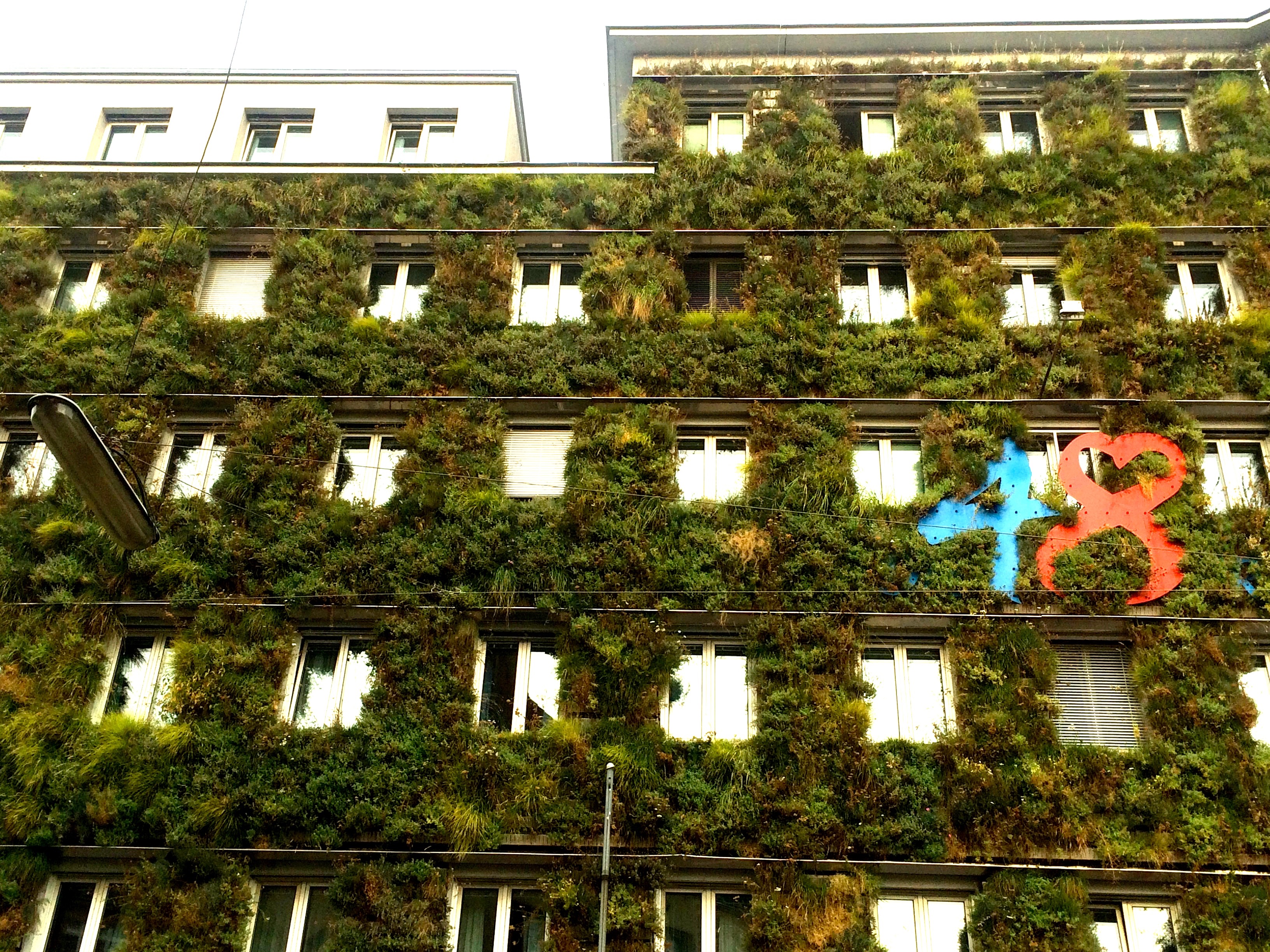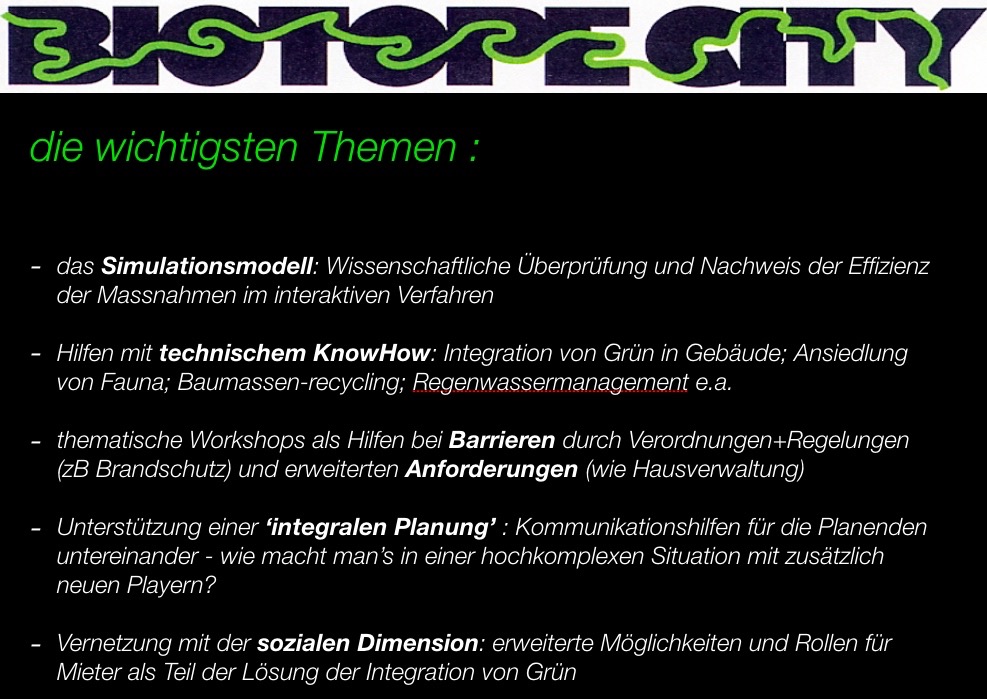
BIOTOPE CITY WIENERBERG – a Biotope City for Vienna





In Vienna, a ‘Biotope City’ district is currently under construction. A neighborhood based on the principles of Biotope City: the realization of a dense urban neighborhood as nature in a close juxtaposition with human, their homes, nearby shops, school, kindergarten, and species of flora and fauna, each with their own, closely interlinked sphere of life.
The neighborhood is developed on the 5.4 hectare site of the former Coca Cola production plant in Vienna. Formerly the site was completely covered with factory buildings. Instead of this a dense, green residential area is planned – even more than that: an area, which will implement the guiding principles of an urban biotope. The area borders along the busy Triesterstrasse, with on its opposite side, the Wienerberg City with its’ closely packed residential towers – an unfortunate heritage of urban misapprehensions of the 80s, which can also be found in Vienna. In the north, however, the area is adjacent to grouping of small houses dating back to the 1930s’, and in the south and east to the Wienerberg and Otto Benesch-Park are large green recreational areas. Only on the northwest corner is there still a small factory, namely, a painters shop. At the moment the construction of all the buildings is nearly finished. First residents will come at the end of 2019.
The History
The impetus for the realization of this concept for the former Coca Cola factory site came from Harry Glück when the Foundation Biotope City and its online journal grabbed his attention. Influenced by anthropologists and biologists, his idea of urban development has always been marked by the perception that humans, former Savannah residents who have not yet developed so much from their history, basically, need two things that are indispensable for their wellbeing: ‘green’ and ‘blue’, chlorophyll and water. Glück had already caused a sensation in the 1970’s with a large project in which he realized both conditions: Alterlaa. This is an area with three gigantic high-rise building of 23 stories, situated in a park, with extensive balcony greening and swimming pools on the roofs. Today the area has a total of about 11.000 social housing tenants living there with a high degree of satisfaction – it is still a highly demanded living area with long waiting lists and, as the owner, a big housing corporation declares, the best project they own.
Attracted by the idea of the City as a type of nature’ proposed by Biotope City Journal, Harry Glück got in contact with the Foundation. His intention was to further develop his own approach to a model of contemporary green, future-oriented urban residential area in Vienna according to the principles of Biotope City.

What does future-oriented urban planning mean?
But, 40 years after Alterlaa, what is still valid from this approach today? What does ‘housing’ for our contemporary living conditions mean? What is future-oriented urban planning now? Our environmental conditions have changed enormously, in particular, the conditions in dense urban areas: Today we are facing severe climate change, and we will have to deal with increasing temperatures, storms and extreme rains in the coming decades. We are already undergoing hot summers, rainfalls often dumping enormous amounts of water in a short time, amounts that normally fell over the course of several months. Storms occur in all seasons including hurricanes, highly unusual for Europe. In addition, the immense increase of urban traffic has led to harmful emissions, which in many large urban areas exceeds admissible health standards.
But there is more: there are great changes in the demographic structure. 40 years ago the social structure of the different city districts was still relatively homogeneous, people of other ethnic backgrounds were rather exceptional. Now in many neighborhoods we find a large number of different languages and different lifestyles living together.
What does urban planning mean today when facing these environmental and social changes?
The concept Biotope City: the City as a form of Nature
The concept Biotope City is based on the idea that, as a consequence of the environmental changes, a strategy of cooperation between city and nature is greatly needed: the mechanisms of self-regeneration, inherent to nature, need to be used today to mitigate further constrains of urban living conditions.
The Biotope City as a Building Construction Program
Studies have shown that planting is an excellent means in many respects:
– For purifying air
– Water retention: Trees, shrubs, green roofs and vertical green contribute to water retention in torrential downpours
– Cooling city temperatures
– Sequestration of fine particulate matter
– Chlorophyll contributes to the active conversion of C02
– A calming affect on inhabitants: Indeed, the inclusion of greening accelerates the recovery process of people who are ill.
To top it off, as research has demonstrated, it is by far the cheapest way to mitigate each of these listed strains, n.b. without additional energy demands!
– 10 % more green can lead to at least a 3˚C temperature drop
– Chlorophyll can absorb a volume of up to 30% fine particulate matter
The Biotope City as a Program for Biodiversity
However, extreme greening of a city has implications: chlorophyll in free urban space (by trees, shrubs, green roofs, green facades) is not possible without the fauna connected with it: insects, birds, reptiles and small mammals. The integration of the ‘natural world ‘ within the city also means a co-habitation for us, the humans, with these natural worlds that are inseparably connected.
This requires a wide-ranging shift in our thinking:
The city can no longer be regarded as the counterpoint to nature; the city has to be understood as a specific form of nature. Actually this is not a new fact, we are only discovering it now: the city is just a specific type of nature, as there are other forms of nature we know in the nature typology: Forest, grasslands, marsh, rocky mountains, dunes etc. Coming from this point of view we at once come to understand that the city is embedded in the complex context of nature.
The Biotope City as Civil Society Program
The concept of Biotope City is admittedly imperfect, even impracticable, when viewed only as a construction task. The measures of greening can be stimulated and supported by investors, owners and municipalities. But they will only lead to long term success if residents feel responsible, too and contribute to the maintenance of the green and get involved in it by own activities. In fact, this happens indeed already in many places and in many forms: window greening, balcony greening, the maintenance of community gardens, the soil around the feet of trees adopted as little garden spots… up to the Green Guerilla and groups protecting rare ‘weeds’ in the crannies of pavements. Also ‘insect hotels’, nesting boxes for various kinds of birds, bat boxes and in home gardens aids for frogs, shrews and other small animals are not uncommon.
Looking at our own urban environment as part of nature, an ‘urban wilderness’, one sees a renewed sense of responsibility arising. A wise and responsible behavior towards all that lives comes into being. With common gardening, common care and the common protection of the gardens together with neighbors a new neighborhood identity is coming into bloom. And we learn from nature: The Amsterdam urban ecologist Martin Melchers has made a wonderful nature film about the wilderness of Amsterdam which demonstrates this aspect beautifully: the fauna he observed is constantly changing through the “introduction” of newcomers, new species arriving in our cities and the already imbedded, native varieties. We live in a stream of constant change that is moving on steadily since the beginning of time. It is precisely this aspect that makes the concept of Biotope an educational program of civil society: learning from nature by working with nature..
Conclusion:
A green skin for the city is efficient + low cost concerning environmental factors:
– Reduction of temperatures
– Reduction of fine particulate matter
– Reduction of CO2 levels
– Rainwater retention
– Windbreakers
– Roof insulation
Concerning social factors of urban gardening and urban farming it supports:
– Neighborhood education beyond ethnic origin and social status
– Responsibility
– Recreation at home








